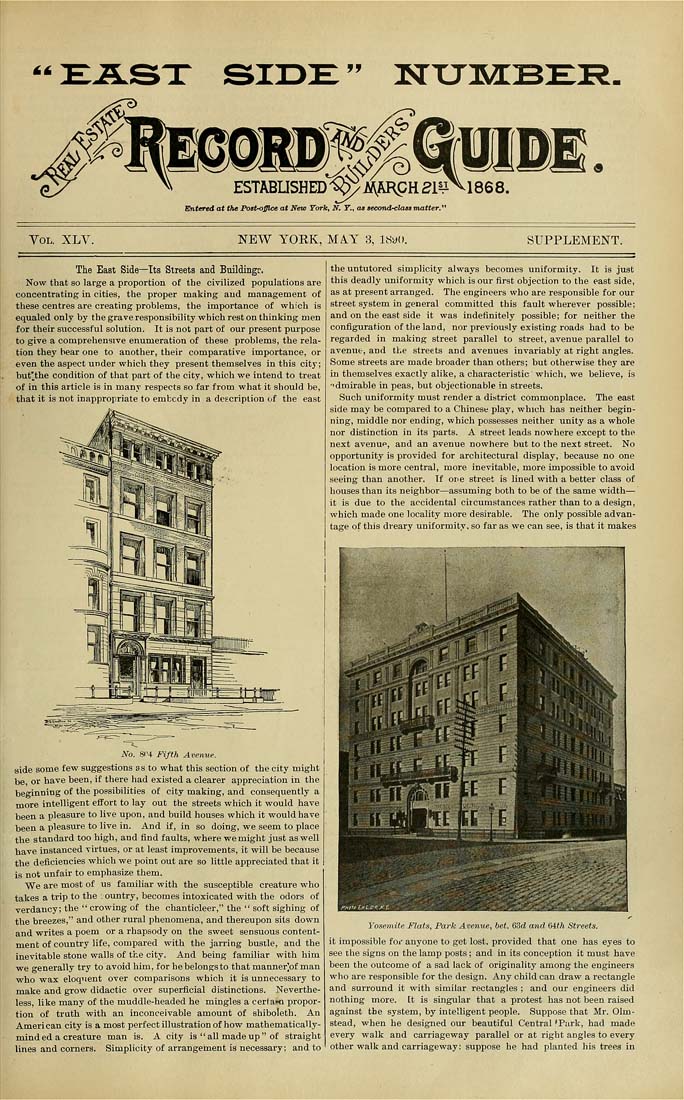Please note: this text may be incomplete. For more information about this OCR, view
About OCR text.
99
ESTABUSHED'^i\ARCH21^^1868.
Entered at the Pott-offlce at New York, If. Y., aa secemd^lass matter."
YoL. XLV.
NEW YORK, MAY 3, 18y{).
SUPPLEMENT.
The East Side—Its Streets and Boildingc.
Now that so large a proportion of the civilized populations are
concentrating in cities, the proper making aud management of
these centres are creating problems, the importance of which is
equaled only by the grave responsibility which rest on thinking men
for their successful solution. It is not part of our present pm-pose
to give a comprehensive enumeration of tiiese problems, the rela¬
tion they hear one to another, their comparative importance, or
even the aspect under which they present themselves in this citj^;
but'the condition of that part of the city, which we intend to treat
of in this article is in many respects so far from what it should be,
that it is not inappropriate to embcdy in a dcecriplion of the east
No. 8i'4 Fifth Avenue.
side some few suggestions as to wbat this section of the city might
be, or have been, if there had existed a clearer appreciation in the
beginning of the possibilities of city making, and consequently a
more intelligent effort to lay out the streets which it would have
been a pleasure to live upon, and build houses which it would have
been a pleasure to live in. And if, in so doing, we seem to place
the standard too high, and find faults, where we might just as well
have instanced virtues, or at least improvements, it will be because
the deficiencies wliich we point out are so little appreciated that it
is not unfair to emphasize them.
We are most of us familiar with the susceptible creature who
takes a trip to the .ountry, becomes intoxicated with the odors of
verdancy; the " crowing of the chanticleer," the " soft sighing of
the breezes," and other rural phenomena, and thereupon sits down
and writes a poem or a rhapsody on the sweet sensuous content¬
ment of counti-y life, compared with the jarring bustle, and the
inevitable stone walls of the city. And being familiar with him
we generally try to avoid him, for he belongs to that raaaneT;of man
who wax eloquent over comparisons which it is unnecessary to
make and grow didactic over superficial distinctions. Neverthe¬
less, like many of the muddle-headed he mingles a cerlawi propor¬
tion of truth with an inconceivable amount of shiboleth. An
American city is a most perfect illustration of how mathematicaUy-
mind ed a creature man is. A city is " all made up " of straight
lines and corners. Simplicity of arrangeinent is necessary; and to
the untutored simplicity always becomes uniformity. It is just
this deadly uniformity which is our first objection to the east side,
as at present arranged. The engineers who are responsible for our
street system in general committed this fault wherever possible;
and on the east side it was indeflnitely possible; for neither the
configuration of the land, nor previously existing roads had to be
regarded in making street parallel to street, avenue parallel to
avenue, and the streets and avenues invariably at right angles.
Some streets are made broader than others; but otberwise they are
in themselves exactly alike, a characteristic' which, we believe, is
■■dmirable in peas, but objectionable in streets.
Such uniformity must render a district commonplace. The east
side may be compared to a Chinese play, which has neither begin¬
ning, middle nor ending, which possesses neither unity as a whole
nor distinction in its parts. A street leads nowhere except to the
next avenup, and an avenue nowhere but to the next street. No
opportunity is provided for architectural display, because no one
location is more central, more inevitable, more impossible to avoid
seeing than another. Tf one street is lined with a better class of
houses than its neighbor—assuming both to be of the same width—'
it is due to the accidental circumstances rather than to a design,
which made one locality more desirable. The only possible advan¬
tage of this dreary uniformity, so far as we can see, is that it makes
Yosemite Flats, Park Avenue, bet. 63d aiut ti4tli titrcvts,
it impossible for anyone to get lost, provided that one has eyes to
see the signs on the lamp posts; and in its conception it must bave
been the outcome of a sad lack of originality among the engineers
who are responsible for the design. Any child can draw a rectangle
and surround it with similar rectangles ; and our engineers did
nothing more. It is singular that a protest has not been raised
against the system, by intelligent people. Suppose that Mr. Olm¬
stead, when he designed our beautiful Central'Park, bad made
every walk and carriageway parallel or at right angles to every
other walk and carriageway; suppose he had planted his trees in
 Prev
Prev
 Prev
Prev








